The no-nonsense guide to weeding your garden easily
Here are the easiest and best ways of weeding your garden.
I’ve asked fellow bloggers, garden experts and YouTubers for their best tips on keeping the garden free of weeds.
If you prefer watching a video to reading a post, see How To Weed Your Garden on the Middlesized Garden YouTube channel.
When is the best time to weed your garden?
You will always have to weed your garden. It is a year-round activity, except during snow and ice.
But spring and early summer is the very best time to get it under control because that is when the weeds are emerging.
Try weeding your garden thoroughly between March and June. After that, you’ll need to weed less.
If I have a job I don’t enjoy, I break it down into manageable chunks by setting a timer for 15 minutes. I weed for exactly 15 minutes, then I allow myself to stop.
If it’s a big job, such as doing a spring tidy-up or de-cluttering a shed, then I’ll do several 15 minute sessions for several days. But if it’s a regular job, then try to do 15 minutes on a regular basis.
Many years before I had a garden of my own, I visited a grand open garden. I was with a friend who knew the owner so we were chatting to her when she suddenly bent down, mid conversation, and removed a weed from the border.
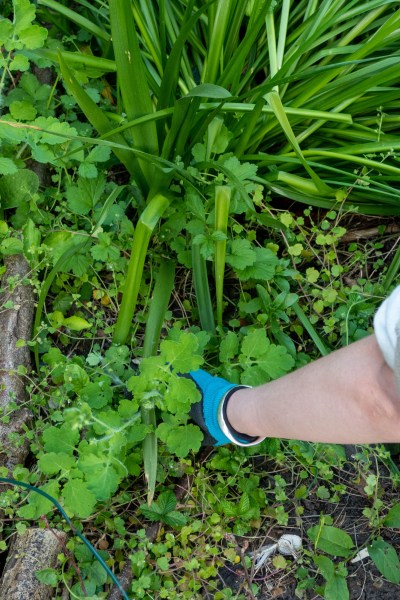
If you pick out a weed every time you see one, you’ll make a big difference to your garden.
I was impressed by this, because she had a team of professional gardeners. But the weeds still grew. And when she saw one, she removed it immediately even if she was in the middle of doing something else.
I’ve always remembered that lesson – that you always need to be alert for weeds and you need to deal with them immediately.
The four basic ways of weeding your garden
There isn’t one way of weeding your garden. There are four basic ways, and I find it useful to use all four depending on the situation. Gardening World presenter and garden designer Mark Lane sums these up:
- Dig out weeds completely by hand, including the roots. If you leave even a scrap of root behind, it can re-grow.
- Cover weeds with a very thick mulch or black plastic. This deprives them of light so they can’t photosynthesise and eventually die off.
- Use weedkillers, either as a spray or a topical application, such as a gel.
- Hoe your weeds.

Award-winning garden designer and Gardeners World presenter Mark Lane.
How to weed your garden quickly
Don’t make the mistake of thinking that spray weedkillers will weed your garden quickly. Going quickly round your garden with a spray is just as likely to kill off or damage the plants you want to keep.
You can fiddle around protecting plants with plastic bags while you spray, but that is not quick.
It may seem counter-intuitive, but hand weeding is probably the quickest and most effective way to weed a garden. If you’re short of time, do ten or fifteen minute sessions. They will soon add up.
The price of victory is eternal vigilance…
The first thing I ever learned about gardening, from a friend of mine who worked with the RHS, was probably the most useful. He told me to weed and mulch all round my garden before even thinking about what new plants to buy.
Do a small section at a time. Hand weed your plants and then cover the area with a layer of well rotted manure, garden compost, bark chippings or other mulch.
This deprives the weeds of light. It slows them down, so fewer re-grow. And when they do grow, they root in the nutritious mulch rather than in the soil. This can make them much easier to pull out when they reappear.
See here for a really simple guide to making compost.
Weeding a neglected garden
If you take over a garden which has been neglected, then you will be faced with a huge number of weeds. You may have to deal with them in different ways.
When Mike and Natalie Newman took over their garden, it had been rented out, then left empty over several years. So it was over-run with weeds and self-seeded trees. They had to use professionals to clear the denser areas of brambles and undergrowth.
However, they hand-weeded the front lawn and kept mowing it. It returned to a normal lawn within a summer.
Read their tips in Where do you start with a neglected garden?’
Because weeds will always reappear…
You can minimise weeds. You can get the most effective weeding tools (see below). But whether you spray everything with the most powerful chemicals or smother every inch of your garden in weed suppressing membrane, you will still get weeds back.
If you have researched ‘weeding’ on the Internet – as I have – you will find people saying that if you lay down horticultural membrane, then you’ll never have to weed again. Like every form of weed control, it does control weeds, very effectively. For a short time.
But if you cover it with gravel or bark mulch, dust and weed seeds settle in that. Annual weeds are blown in by the wind and grow on top.
Weeds can also pop up around the sides of a light excluding mulch. And if you cut holes in it to plant, then weeds will grow out of the holes with the plants.
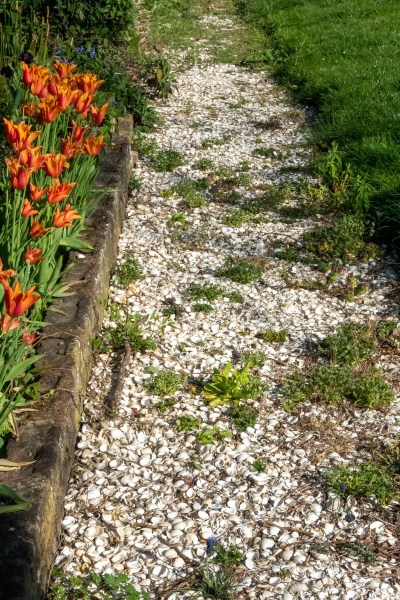
My weed-filled path. This has a weed suppressing membrane under it. Weed suppressing membranes suppress perennial weeds directly below them. However annual weeds soon settle on top. The perennial weeds’ roots will also snake out under the edges of the membrane and set themselves up in an adjacent border.
Once you have accepted that weeds will always come back, then weeding becomes much easier. You’re no longer fighting a losing battle. You can work out a strategy that works for you. Think of weeding as being like brushing your hair.
You can choose an easy-care hair style, and get the best hairbrush for your hair. You can decide that you like the un-brushed look. But you will regularly – usually daily – have to brush your hair.
Although I must admit that my garden is often full of weeds and my hair could be tidier.
Weeding without chemicals
There are four ways to weed listed above. Three of them involve weeding without chemicals. If you don’t want to use chemicals in your garden, then stick to a combination of hand weeding, hoe-ing and a light-excluding mulch.
There are recipes on the internet for killing weeds with salt, vinegar or boiling water. They are all contact herbicides, which means they kill the leaves they touch. They don’t kill the roots. But they also kill any other leaves they touch, so it is difficult to use them in a crowded border.
If you re-apply often enough, the roots will die off. But wouldn’t it be less effort to hand-weed them out in the first place?
Salt, vinegar or boiling water?
Just because something is home-made, it doesn’t automatically mean it is safe.
Or that it is cheaper. The University of Maryland did a study on using vinegar as a household weed-killer. They worked out that, by the time you have killed the weeds properly with a vinegar solution, you would have spent more on vinegar than you would have done on commercial weed killer.
‘Agricultural vinegar’ is the most effective weed killer but it has 20% acetic acid and can burn your skin or eyes badly. It should not be used by amateurs.
And salt leaches into the soil. It can damage the vital micro-organisms in the soil. You may have problems planting in that area.
As for boiling water – how do you keep a kettle boiling as you rush down the garden to that patch of bindweed at the bottom?
The best weeding tools
Garden designer Lee Burkhill of the Garden Ninja youtube channel thinks that the Japanese gardening knife or hori hori is the best tool. He’s also got a video on killing weeds with weed burner. You may like to consider it, as I haven’t covered weed burners here.

Garden designer, Lee Burkhill of the Garden Ninja YouTube channel.
I also use something similar – I think it’s known as a patio knife, and it’s a garden knife with a right angled tip, designed to scrape out weeds between patio pavers. Mine is the Wolf Garten Garden Scraper. I first discovered it when I saw a professional gardener use it for all kinds of weeding and since then I’ve used nothing else.

My weeding tools – a dandelion weeder from Spear & Jackson and a dandelion trowel from Sneeboer, as well as the Wolf Garten scraper.
For weeds with a deep tap root, such as dandelions, my husband uses something that looks like a very thin, long hand trowel. And, of course, you can always use a hand fork.
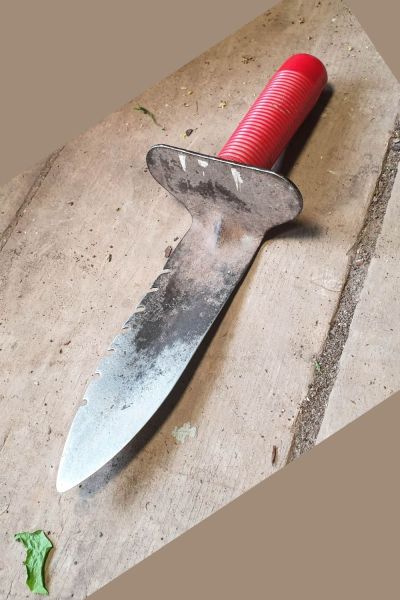
This is an American weeding knife, and it belongs to Tom Coward, head gardener at Gravetye Manor Hotel. It’s very similar to a hori-hori.
Use a light excluding mulch
The second method Mark Lane mentions is to cover your border completely with black horticultural plastic or similar (many people use cardboard, which slowly decomposes into compost. It’s a good way of getting rid of a whole bed of perennial weeds.
So I asked organic gardener Charles Dowding of the Charles Dowding Youtube channel about this.
Charles advises starting in February while the weeds are still dormant. ‘It will take about three to four months to kill off creeping buttercup in this way, but couch grass will take until around August. And bindweed can survive under light-excluding matting for a couple of years.
As you won’t want to cover your border for two years, Charles suggests covering it for one season ‘to weaken the bindweed.’ Then follow up with regular hand weeding – you need to do it every week.
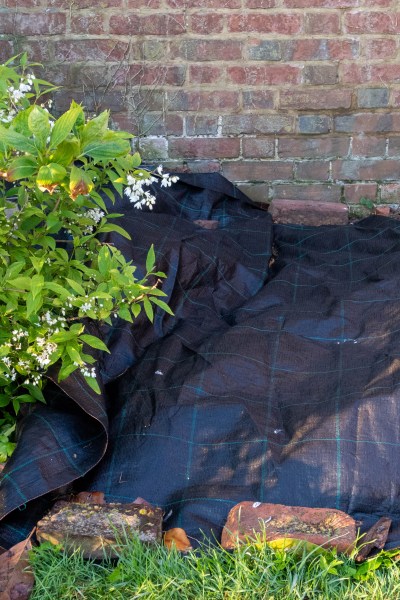
I’m clearing a patch of ground elder by leaving it covered with horticultural membrane for a summer. I have to check around the edges regularly and also weight it down well. I left this on for around a year, and have since planted it with comfrey. The comfrey is vigorous and out-competes the ground elder.
You will need to weigh down the black plastic as I have found that the wind whips it off quite easily.
And check around the edges. Many perennial weeds have incredibly long roots – this is just one piece of bindweed I got out from a border, so you can see how a root could easily survive on an adjacent border and sneak back.
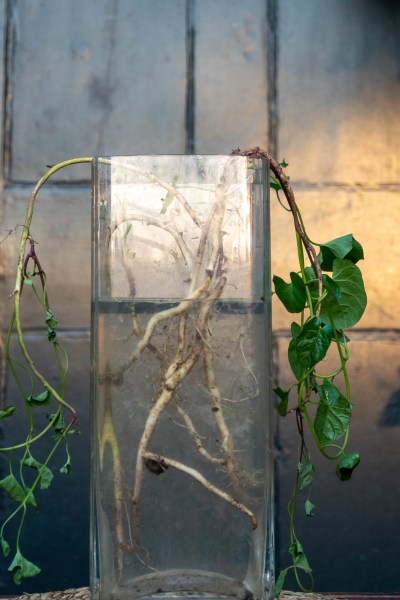
All this is just one strand of bindweed which I weeded out of my garden yesterday. Those roots can travel!
There are also living mulches that break down over time to feed the soil, such as bark mulch, chipped wood and straw mulch. I’m trying out a layer of straw mulch (Strulch) on my veg borders at the moment.
The idea is that it deprives annual weed seeds of light. It’s been on for around 5 weeks, and it has certainly slowed down the growth of weeds, but it hasn’t stopped them.
It’s not a substitute for regular hand weeding – it just means that every session of regular hand weeding can be done quite quickly. There are fewer weeds and those which do grow come out really easily.
If you do want to use chemical based weed killers
Mark also mentions chemical sprays. He recommends a spot treatment on plants rather than sprays.
I agree completely because I have found it impossible to protect the plants adjacent to weeds when using a spray.
I cover them with plastic or I cover the weeds with a plastic bag and spray inside that and I only spray on wind free days, but the weedkiller spray always always affects the plants beside it.
However, it’s also worth pointing out that dabbing a spot of weed killer on each leaf is as time consuming as weeding by hand.
How to hoe
And then there’s hoeing. I asked Charles Dowding how to hoe. He says you need to start hoeing as soon as you see the tiniest shimmer of green: ‘There’s a saying that you need to start hoeing your weeds before you can see them.’
Just tickle the surface of the earth – the top few inches – with the hoe, chopping off the heads of any annual weeds. He just leaves the weed heads on the earth.

Charles Dowding of the Charles Dowding YouTube channel and author of many books including Organic Gardening, The Natural No Dig Way. I talked to Charles to find out how no-dig/no till works for flower gardens.
Hoe-ing is not a heavy activity. It’s particularly suitable for plants in rows, such as vegetables. And you can cover a lot of area in a short time.
Charles uses an oscillating hoe. I have just ordered one (not the same brand as Charles’).
Other ways of making weeding easier
As well as using good tools, there are other ways of making weeding a bit easier.
Disposing of weeds adds to the work.
Alex Mitchell, gardening journalist and author of Crops in Tight Spots, on growing vegetables in small spaces, says she ‘just turns annual weeds into the soil so they rot down, as long as they haven’t flowered,’ she says. She also lets perennial weeds die completely then adds them to her compost heap.
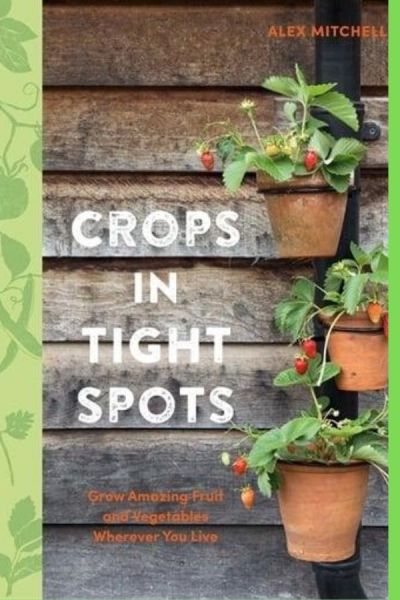
Crops in Tight Spots by Alex Mitchell
Liz Zorab of the YouTube channel Liz Zorab -Byther Farm is a ‘homesteader’ (someone who aims for a self-sufficient lifestyle). She only only weeds where she needs to – which is the vegetable bed. Vegetables really hate the competition from weeds.
So if your weeding time is limited, start with the veg patch.
Note that links to Amazon are affiliate, which means I may get a small fee if you buy but it won’t affect the price you pay. Other links are not affiliate.
Weeding your garden with the help of friends and family
And then there’s getting help.
Blue Peter presenter and Skinny Jean Gardener podcaster, Lee Connelly, author of How to Get Kids Gardening, says that children will enjoy helping you weed if you make it a competition – ‘see who can fill the biggest bucket.’
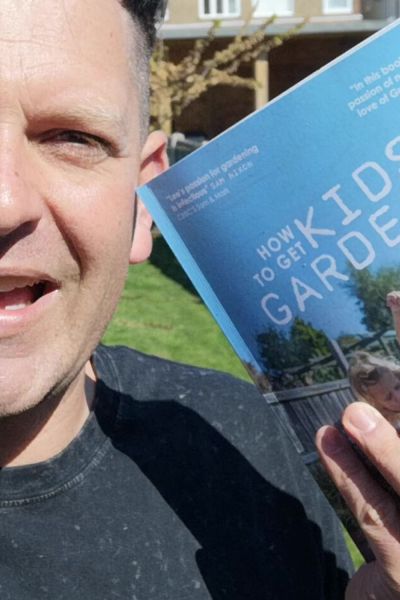
Skinny Jean Gardener, Lee Connelly and his book, How to Get Kids Gardening. The book has lots of tips and tricks to help you encourage your children into gardening. It makes gardening a fun activity for the family, and could give them a lifelong love of it.
There’s always the issue of whether children or other helpers can tell the difference between weeds and plants you want to keep, in which case here’s an easy trick. Mr Middlesize weeds our paths and terrace, but has no intention of learning anything about either plants or weeds. So I tell him that if there’s a plant growing on the path, it shouldn’t be there, so it’s a weed.
Pay someone else to do your weeding
If you really hate weeding, can you afford a gardener? Even gardening professionals often pay someone else to help them.
A trained gardener can weed far more efficiently than you can. This post will help you find the right gardener for your garden and give you some ideas on what you should pay. It’s not a minimum-wage job. Gardeners have to be trained, and they need proper tools and professional insurance.
‘De-classifying weeds…’
You can also cut down on weeding your garden by cutting down on the number of plants you consider weeds. Many weeds are effectively wild flowers. They are hugely important for wildlife, especially pollinators.
So there’s a trend towards tolerating or encouraging plants that would have been yanked out as weeds just a few years ago.
As Jack Wallington, garden designer and author of Wild About Weeds, says ‘Re-assess the weeds in your garden and see if you can even find one you’re happy to tolerate, because not having to weed it out will make your gardening easier and more pleasurable.’
Wild About Weeds will help you work out which weeds to keep and which to weed out. Read my interview with Jack here.
And there are also some local gardens where weeds play an important part – see are we seeing a new direction in weeds.

These Spanish bluebells are considered weeds by some people because they are very invasive. On the left hand side of the dog is a creeping buttercup, which definitely is an invasive weed. I can tolerate the bluebells, though I do pull quite a few up every year. The creeping buttercup has to go.
People are now questioning many of the gardening jobs we’ve always assumed were essential. You don’t have to dig – see no dig for flower borders. And you may not need to clear away all your leaves in autumn. See leave the leaves to find out how little weed blowing and raking you really need to do.
Turn your weeds into tea…
Weeds have their uses. Some gardeners even make tea with their weeds.
Nick Moyle of the Two Thirsty Gardeners blog has a new book out called Wild Tea. It has recipes for making teas from several weeds – nettles and dandelions, as well as from a range of garden plants, such as rhubarb, thyme, bay, borage or rose.
Nick says “I always see if there’s a good reason for declassifying a plant as a ‘weed’ in my garden before despatching it. Can I eat it? Can it be turned into a drink? Does it look nice? Does the wildlife appreciate its presence? Once I’ve gone through that assessment I’m not left with much, apart from bindweed and couch grass – and for that I have no tips, other than a long, labour intensive battle.”
Change your weeding mindset…
Perhaps one of the best ways of weeding your garden is to change your mindset.
My daughter has been living with us, working from home. At the end of the day, she does fifteen minutes weeding because it gives her eyes a rest from the computer screen and she enjoys the fresh air.
Recent research has shown that turning the earth while weeding releases microbes into the air. When you inhale them, your serotonin levels rise and you feel more relaxed.
Think positive…
A friend of mine very kindly weeds my garden when she comes to stay, because she says she finds it relaxing. I’m always thrilled at the bags of weeds that pile up behind her.
But, until recently, I hadn’t realised that I should have followed up on the beds she weeded, even just for a few minutes a day. I had thought ‘oh, good, that border won’t need weeding for a month or so.’ By which time it was thick with weeds again.
So perhaps it’s time to consider weeding your garden as therapy for you, not just for your garden.
And like many therapies, it’s something you have to keep on doing.
Pin to remember weeding your garden
And do join us every Sunday morning for tips, ideas and inspiration for your garden.
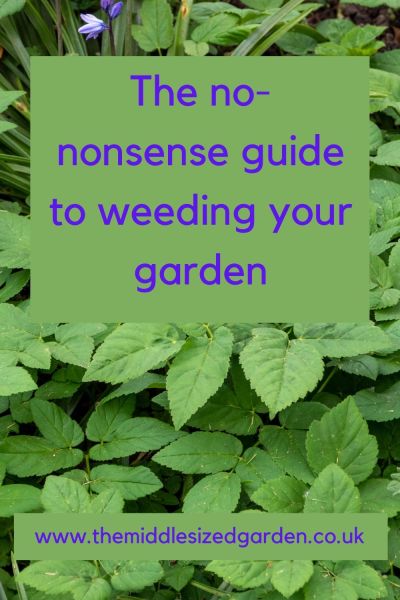























Much useful information! I very much look forward to your weekly newsletters…Thank you!
Thank you so much!
77yrs and bending difficult and no strength In hands and legs, do have a gardener once a week for big stuff but no-time to weed; easy suggestions
A quick question. After hand weeding (and sieving the soil to remove every bit of weed), we lay a membrane and cover with slate (having left space for established plants). It’s certainly not perfect as the ground elder is coming through the membrane after 2 years, but it does slow growth down massively allowing us to move around the garden over the year. My question is, will the soil receive nutrients through the membrane and slate? I’m worried that I’m damaging the soil.
Most gardeners I know don’t like membranes because the worms can’t reach up through them and operate to keep the soil healthy. And their weed suppressing qualities are somewhat temporary as seeds and dirt settle on top or, as you’ve noticed, the pernicious perennial weeds find a way round it. The soil won’t receive nutrients through the membrane. Many gardeners I know either don’t use membranes at all or use them for a short period to knock the weeds back, after which they rely on hand weeding the remainder. In terms of the pernicious weeds, such as the ground elder, it’s just an endless battle, but having slowed their growth with the membrane, you may be able to tackle them now with hand weeding. Good luck. I am in a similar situation and have been using cardboard instead of a membrane. It breaks down and is good for the soil, but it slows weeds a bit before doing so.
Thank you for this informative post! Very interesting points were made regarding the homemade weed-killers – my friend uses vinegar all the time and I was wondering if it was actually worth it…
Thank you. I think people forget that vinegar isn’t free – you still have to buy it, you still have to apply it (so it’s not ‘no work’) and too much of it can be damaging – as with all weed killers. But if people prefer it, that’s fine – it’s just not a magic solution. The most natural and least damaging solution is hand weeding or hoeing.
The past year or 2 I have got much more into ungardening, yet still want my garden to look delicious! I have embraced the Dandelions, I’ve even brought some back fromwirk with me to rehome them in my garden. Last year a magnificent Scottish Thistle seeded in my membraned and gravelled yard area- The Bees LOVED it the it and then left it to seed which brought the Goldfinches in. I’m happy to report there are 2 more coming up this year! Otherwise, my main tip for keeping weeds at bay is to FILL a border with plants that you want- obvs this is more difficult with the thugs but is good for more well behaved perennials and annuals
Fill a border is excellent advice for keeping weeds down,and I wish I’d remembered to include it. But thank you, you’re absolutely right.
Thank you. More motivated to enjoy the smell of God’s earth
Great post with so much useful information. Thank you.
Thank you!
Alexandra,
I just love your weekly blog, something to always fill me full of enthusiasm as I begin to flag at the weeks end. The subjects of each blog are always packed so full of relevance to the time of year and also your delivery usually makes me have a wry smile or two. Well done!
Thank you so much!